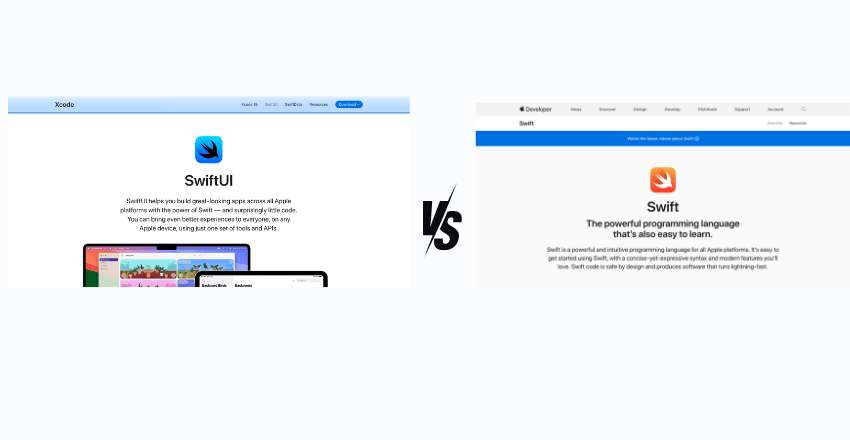SwiftUI vs. Swift: SwiftUI and Swift are two popular frameworks used for iOS app development, but understanding their differences and benefits is crucial in choosing the right one for your project. SwiftUI is a declarative framework that provides an intuitive and consistent experience for building user interfaces, while Swift is a powerful and fast programming language.
Introduction to SwiftUI and Swift
SwiftUI is a declarative framework for building user interfaces, while Swift is a powerful and fast programming language developed by Apple. Together, they have revolutionized iOS app development, offering developers a modern and efficient way to create beautiful and interactive apps.
With SwiftUI, developers can write code in a much simpler and more expressive way. It provides a declarative syntax, allowing developers to describe the desired UI and behavior of their app, and SwiftUI takes care of the rest. This means less code, less complexity, and faster development times.

On the other hand, Swift is the underlying programming language used with SwiftUI. It is designed to be intuitive, safe, and performant. Swift combines the best features of many programming languages, making it easier for developers to write clean and efficient code. With Swift, developers have access to a vast ecosystem of libraries and frameworks that can be used alongside SwiftUI to enhance app functionalities.
When developing iOS apps, it is essential to understand the relationship between SwiftUI and Swift. SwiftUI is built on top of Swift, leveraging its powerful features and syntax while providing a more streamlined and modern approach to UI development. By using both SwiftUI and Swift together, developers can create immersive user experiences that combine the simplicity of declarative UI with the power of a robust programming language.
Table: Key Features of SwiftUI and Swift
| SwiftUI | Swift |
|---|---|
| Declarative syntax | Powerful and fast |
| Built-in data binding and event handling | Intuitive and safe |
| Dynamic layout handling | Access to a vast ecosystem of libraries |
| Optimized performance | Support for modern iOS features |
SwiftUI and Swift have transformed the landscape of iOS app development. With SwiftUI’s declarative syntax and Swift’s powerful capabilities, developers can create visually stunning, highly responsive, and efficient apps. Whether you are a beginner or an experienced developer, embracing both SwiftUI and Swift will undoubtedly elevate your app development skills and enable you to build exceptional experiences for iOS users.
Ease of Learning

SwiftUI is generally considered easier to learn for beginners, while Swift may be more familiar to developers already proficient in the language. SwiftUI’s declarative syntax and intuitive design make it approachable for those new to iOS app development. With SwiftUI, developers can build user interfaces by simply describing the desired end result, rather than having to manually manipulate views and manage complex layout constraints.
For beginners, SwiftUI offers a shorter learning curve compared to Swift. The framework provides a more visual and interactive development experience, with real-time previews and drag-and-drop capabilities in Apple’s Xcode development environment. This allows beginners to see immediate results and experiment with different UI components, making the learning process more engaging and less overwhelming.
However, for developers already proficient in Swift, the learning curve for SwiftUI may not be as significant. Swift developers are already familiar with the language’s syntax and concepts, which can provide a solid foundation for understanding SwiftUI’s underlying principles. It may take some time to adjust to the declarative nature of SwiftUI and the new set of UI components it introduces, but the transition can be smoother for experienced Swift developers.
Overall, SwiftUI’s beginner-friendly approach and visual development tools make it an attractive option for those new to iOS app development. Swift developers can also benefit from SwiftUI’s modern approach and efficient workflows, once they become familiar with the framework’s unique features and concepts.
| Key Points | SwiftUI | Swift |
|---|---|---|
| Learning Curve | Easier for beginners | Familiar for Swift developers |
| Visual Development | Real-time previews, drag-and-drop | N/A |
| Swift Proficiency | N/A | Beneficial for understanding SwiftUI |
SwiftUI as a Wrapper for UIKit
It is important to note that although SwiftUI is used for iOS development, it is essentially a wrapper that utilizes UIKit behind the scenes. SwiftUI provides a declarative and intuitive way to build user interfaces, but it still relies on the underlying functionalities of UIKit to power its functionalities.
One of the benefits of SwiftUI being a wrapper for UIKit is the seamless integration with existing UIKit components and libraries. Developers can leverage their knowledge of UIKit and easily incorporate it into SwiftUI projects. This allows for a smooth transition and compatibility with existing codebases, making it easier to adopt SwiftUI in iOS development.
Table: SwiftUI and UIKit
| SwiftUI | UIKit |
|---|---|
| Declarative framework | Imperative framework |
| Modern and efficient approach | Greater control and flexibility |
| Built-in data binding and event handling | Requires manual implementation |
| Dynamic layout handling | Manual arrangement with frames and constraints |
| Optimized layout engine for performance | Efficiency dependent on developer implementation |
While SwiftUI offers a more modern and efficient approach to iOS development, there are still scenarios where UIKit’s greater control and flexibility may be preferred. The choice between SwiftUI and UIKit ultimately depends on the specific needs and complexity of the project at hand.
Overall, SwiftUI serves as a powerful tool that simplifies the process of building user interfaces by wrapping around the underlying UIKit framework. Its integration with UIKit allows developers to combine the best of both worlds, leveraging the strengths of each framework to create outstanding iOS applications.
Data Binding and Event Handling
One of the advantages of SwiftUI over UIKit is its built-in data binding and event handling capabilities, simplifying the management of data flow in an app. With SwiftUI, developers can easily bind data to user interface elements, ensuring that changes in the data automatically update the corresponding views. This eliminates the need for manual synchronization between the model and the view, reducing the chances of inconsistencies and saving development time.
In addition to data binding, SwiftUI also provides seamless event handling. Developers can attach actions to various user interactions, such as button taps or gestures, using simple and intuitive syntax. This allows for smoother user experiences and more interactive app interfaces. With UIKit, event handling requires additional code and can be more complex to implement.
SwiftUI’s built-in data binding and event handling features offer significant advantages for app development. By simplifying the management of data flow and providing seamless event handling, SwiftUI empowers developers to create more efficient and interactive user interfaces.
Layout Handling
When it comes to layout handling, SwiftUI offers a more dynamic approach, adjusting layouts based on the content and size of the interface, unlike UIKit that requires manual arrangement using frames and constraints. With SwiftUI, developers can take advantage of the declarative syntax to define their user interfaces, allowing the framework to automatically handle layout adjustments as needed.
This dynamic layout capability of SwiftUI simplifies the development process and reduces the need for explicit layout calculations. Instead of specifying fixed dimensions and positioning for each element, SwiftUI allows developers to define the desired layout using stacks, spacers, and alignment guides. This makes it easier to create responsive and adaptable user interfaces that can adapt to different screen sizes and orientations.
Dynamic Layout Example
“With SwiftUI, you can create a flexible and fluid layout like never before. For example, you can use a VStack to stack multiple views vertically, and the layout will automatically adjust based on the content and available space. You can even mix different types of views within the stack, such as text, images, and buttons, and SwiftUI will handle the layout adjustments seamlessly.”
In contrast, UIKit requires developers to manually specify the frames and constraints for each element in the interface using code. This traditional approach can be time-consuming and error-prone, especially when dealing with complex layouts or frequently changing content. It often requires fine-tuning and adjustments to ensure everything appears correctly on different devices.
With SwiftUI’s dynamic layout handling, developers can focus more on the structure and design of their app’s user interface, without getting bogged down in the details of layout calculations. This allows for faster and more efficient development, resulting in more polished and visually appealing iOS apps.
| SwiftUI | UIKit |
|---|---|
| Dynamic layout handling | Manual arrangement using frames and constraints |
| Declarative syntax | Imperative coding |
| Automatic layout adjustments | Explicit frame and constraint calculations |
Performance Comparison

When it comes to performance, SwiftUI boasts a more optimized layout engine compared to UIKit, resulting in improved app performance with faster rendering and responsiveness. SwiftUI’s layout system is based on a declarative approach, where the layout is automatically recalculated when changes occur, ensuring that the interface stays in sync with the underlying data.
One of the key advantages of SwiftUI’s optimized layout engine is its ability to reduce the number of redraws and updates needed when the interface is modified. This leads to a smoother user experience and better overall performance. Additionally, SwiftUI uses advanced techniques like pre-rendering and partial recomposition to further enhance performance, making it ideal for building highly interactive and visually rich applications.
On the other hand, UIKit relies on a more traditional approach to layout, using frames and constraints to define the position and size of UI elements. While UIKit provides a high level of control and flexibility, it can be more time-consuming and complex to work with, especially for complex user interfaces. This can result in slower rendering and potentially less responsive apps compared to those built using SwiftUI.
| Framework | Performance |
|---|---|
| SwiftUI | Improved app performance with faster rendering and responsiveness |
| UIKit | Potentially slower rendering and less responsive apps |
SwiftUI’s more optimized layout engine offers significant performance advantages over UIKit. Its declarative nature and automatic recalculations result in faster rendering and improved responsiveness, providing a smoother and more intuitive user experience. Developers looking to build high-performance iOS apps should consider using SwiftUI for its modern approach and performance benefits.
Choosing Between SwiftUI and UIKit
The choice between SwiftUI and UIKit ultimately depends on the complexity and specific requirements of your project. SwiftUI, as a modern and efficient approach, offers a range of benefits for iOS app development. With its declarative syntax and built-in features, it provides an intuitive and consistent experience for building user interfaces.
Benefits of SwiftUI
One of the key advantages of SwiftUI is its ease of learning, especially for beginners. Its simplified syntax and intuitive design make it accessible to developers new to iOS app development. SwiftUI also offers built-in data binding and event handling features, streamlining the management of data flow in your application.
Another benefit of SwiftUI is its dynamic layout handling. Unlike UIKit, which requires manual arrangement using frames and constraints, SwiftUI adjusts the layout based on content and size. This allows for a more flexible and responsive user interface without the need for complex calculations or constant updates.
| SwiftUI | UIKit |
|---|---|
| Declarative syntax | Imperative syntax |
| Built-in data binding and event handling | Manual data management |
| Dynamic layout handling | Manual arrangement with frames and constraints |
When it comes to performance, SwiftUI’s optimized layout engine ensures faster and more responsive apps. By leveraging its advanced rendering and animation capabilities, SwiftUI enhances the overall user experience.
However, it’s important to note that SwiftUI is not a replacement for UIKit in iOS development. Instead, it acts as a wrapper that relies on UIKit behind the scenes. This means you can still utilize UIKit for specific functionalities or take advantage of SwiftUI’s interoperability with UIKit components.
In contrast, UIKit provides greater control and flexibility, making it suitable for projects with complex requirements or specific design constraints. It allows for fine-grained customization and access to a wider range of third-party libraries and frameworks.
Ultimately, the choice between SwiftUI and UIKit depends on your project’s needs. If you prioritize a modern, efficient, and streamlined development experience, SwiftUI is a compelling choice. However, if you require granular control and flexibility, especially for complex projects, UIKit remains a powerful and reliable option.
Wrapping up

While SwiftUI and Swift are both powerful frameworks for iOS app development, the decision between the two ultimately depends on the project’s specific needs, complexity, and the developer’s familiarity with Swift.
SwiftUI offers a more modern and efficient approach to building user interfaces, with its declarative syntax and built-in features for data binding and event handling. It provides an intuitive and consistent experience, making it easier for beginners to learn and for experienced developers to work with. Its dynamic layout handling based on content and size also simplifies the process of creating responsive designs.
On the other hand, UIKit, the foundation of iOS development, provides developers with greater control and flexibility. It allows for fine-grained customization and precise layout management through frames and constraints. For projects that require extensive customization or have complex UI requirements, UIKit may still be the preferred choice.
Ultimately, the decision between SwiftUI and UIKit should be based on a thorough assessment of the project’s needs and the developer’s expertise. For simple apps or those that can benefit from SwiftUI’s streamlined approach, it may be the ideal choice. However, for projects with specific requirements or where fine-grained control over the UI is crucial, UIKit remains a reliable and powerful option.
FAQ
Q: What is the difference between SwiftUI and Swift?
A: SwiftUI is a declarative framework for building user interfaces, while Swift is a programming language. SwiftUI provides a more intuitive and consistent experience for building UIs, while Swift is a powerful and fast programming language.
Q: Is SwiftUI easier to learn for beginners?
A: Yes, SwiftUI is generally easier to learn for beginners due to its declarative nature and intuitive syntax. However, for those already familiar with Swift, it may not necessarily be any easier.
Q: Will SwiftUI replace UIKit in iOS development?
A: No, SwiftUI will not replace UIKit. It is actually a wrapper that relies on UIKit behind the scenes. While SwiftUI offers a more modern approach to UI development, UIKit still remains a crucial part of iOS development.
Q: What are the data binding and event handling features of SwiftUI?
A: SwiftUI offers built-in data binding and event handling features, making it easier to manage the flow of data in an app. These features allow for seamless updates of UI components based on changes in the underlying data model.
Q: How does SwiftUI handle layout compared to UIKit?
A: SwiftUI dynamically handles layout based on content and size, eliminating the need for manual arrangement with frames and constraints. In contrast, UIKit requires developers to manually specify the layout using frames and constraints.
Q: Is SwiftUI more performant than UIKit?
A: Yes, SwiftUI has a more optimized layout engine, leading to faster and more responsive apps compared to UIKit.
Q: How do you choose between SwiftUI and UIKit for a project?
A: The choice between SwiftUI and UIKit depends on the specific needs and complexity of the project. SwiftUI provides a modern and efficient approach, while UIKit offers greater control and flexibility. Consider the project requirements and your familiarity with each framework when making a decision.
Source Links
https://asilarslan.medium.com/what-is-the-difference-between-swift-and-swiftui-4f88ace93411
https://stackshare.io/stackups/swift-vs-swiftui
https://levelup.gitconnected.com/uikit-vs-swiftui-a-developers-dilemma-1d2b2e5d0149













